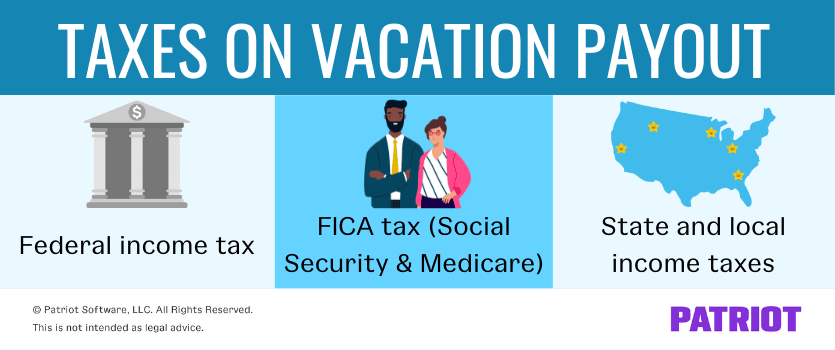Many business owners give their employees paid time off (PTO) or vacation pay throughout the year. At the end of the year, employees can either cash out, roll over, or lose unused time. If you allow employees to cash out their unused vacation time, you need to know how to handle the payout. Luckily, the IRS has some guidance on how to handle taxes on vacation payout.
Taxes on vacation payout
Again, the IRS provides information on how to handle a lump-sum vacation payout. IRS Publication 15 states that an annual lump-sum payout for unused vacation time is a supplemental wage for employees (which we’ll get to in a minute).
Employers do not use different tax rates if an employee takes time off of work and uses their vacation time. Instead, employers must treat used vacation time as typical wages. So, you must calculate federal income, Social Security, Medicare, state income, and local income taxes.
In the case of paying employees for unused time off, the tax withholding on vacation payout differs in a couple of ways. The Social Security and Medicare tax withholding does not change. Employers still calculate 6.2% for Social Security for both employer and employee. And, Medicare is still 1.45% for both employer and employee.
But, there’s a flat tax rate option for federal income tax for supplemental wages. And, some states also have a supplemental tax rate for state income tax.

What is a supplemental payment?
Is vacation pay considered a supplemental payment? Again, the IRS identifies vacation payout wages as supplemental wages. So, what exactly are supplemental wages?
Supplemental wages are any wages in addition to an employee’s base pay. Examples of supplemental pay includes:
- Bonuses
- Commissions
- Overtime pay, if not treated as regular wages
- Severance pay
- Back pay
- Reported tips
- Retroactive pay increases
- Awards
- Prizes
- Payments for nondeductible moving expenses
- Payments for accumulated sick leave
Tax rate on vacation payout
The federal supplemental flat tax rate is 22% for federal income tax only. But, there are different methods to withhold income taxes for the supplemental payment of a lump-sum vacation payout.
The IRS says that the way you withhold depends on two factors:
- If you withheld or did not withhold income tax from the employee’s regular wages in the current or previous years
- How you plan to pay the supplemental wages to the employee
Here are the ways to withhold FIT on vacation payouts, according to Publication 15:
- If you withheld income tax from an employee’s wages during the current or prior year, you can:
- Withhold a flat 22%
- Pay vacation payouts concurrently with regular wages as one total and calculate FIT as if the total is a single payment for a regular pay period
- Pay supplemental wages separately from regular wages. Add together the employee’s regular wage amount and the vacation payment amount. Find the tax liability on the total. Then, subtract the employee’s tax liability for their regular wages from the total tax liability. Use the difference as the amount of tax to withhold for the vacation payout.
- If you did not withhold income tax from an employee’s wages in the current or prior year:
- Pay vacations payouts at the same time as you pay an employee their regular wages. Calculate FIT as if the total wage amount is a single payment for a regular payroll period.
Is the vacation payout tax rate in addition to standard federal income tax withholding?
If a business decides to pay out vacation time as supplementary income to employees, the federal income tax rate is only the flat tax rate of 22%. Do not withhold the standard federal income tax rates for employees plus the 22%.
For example, an employee has 40 hours of unused vacation time. The employee earns $12.50 per hour, so the gross pay for the vacation payout is $500 (40 X $12.50). Multiply $500 by the vacation payout tax rate of 22% to determine how much federal income tax to withhold for the payment ($110).
Why pay out vacation time?
Employers may pay out vacation time at the end of the year for a few reasons. For example, you may have a policy in place that states that employees cannot roll time over to the next year. But, your state may have laws that prevent “use it or lose it” policies. In that case, you must pay out the unused time to the employees at the end of the year.
By contrast, you may allow your employees to roll time over to the next year up to a specific number of hours. Over that set amount, employees can take a payout. For example, you allow employees to roll over a maximum of 40 hours. Employees with more than 40 hours can cash out the remainder.
What is a use-it-or-lose-it policy?
Federal laws do not require employers to offer vacation policies to their employees. And typically, state laws do not require employers to offer paid time off or vacation time. But, some states do have laws regarding vacation time if a business offers it to its employees.
A use-it-or-lose-it policy states employees cannot receive a payout or roll over unused paid time off, such as vacation time. Instead, employees forfeit their unused time if they do not use all of it during the year.
Not all states have laws regarding use-it-or-lose-it policies. Understand PTO payout laws by state to remain compliant. And if your business has employees in different states, check out the laws in each state where an employee resides.
This is not intended as legal advice; for more information, please click here.